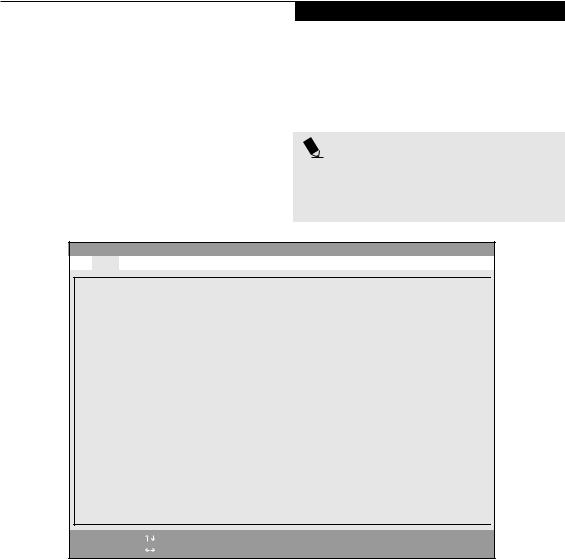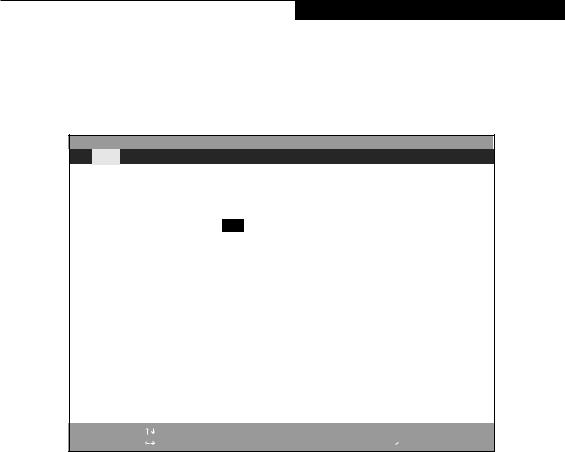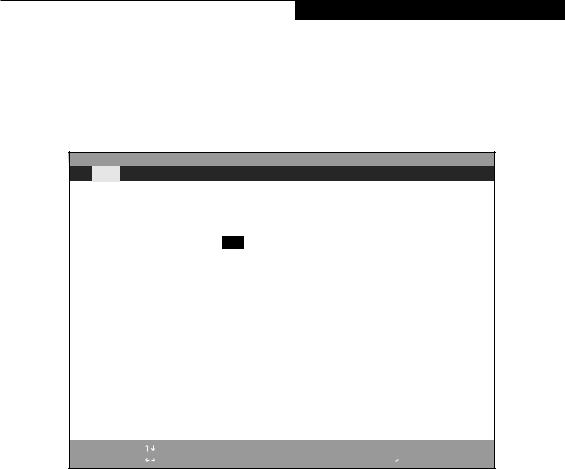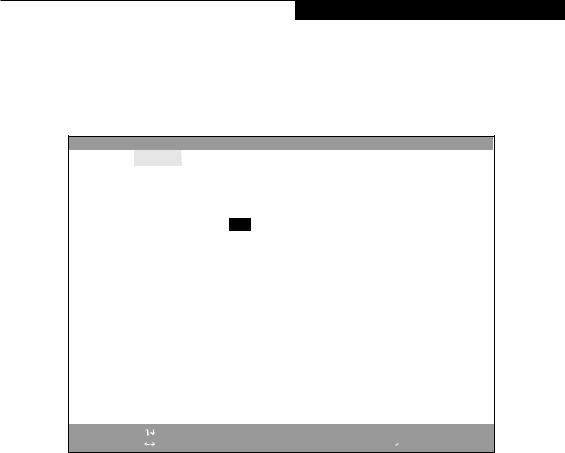Fujitsu LifeBook I4177 User Manual

i Series BIOS
BIOS SETUP UTILITY
The BIOS Setup Utility is a program that sets up the operating environment for your notebook.Your BIOS is set at the factory for normal operating conditions, therefore there is no need to set or change the BIOS environment to operate your notebook.
The BIOS Setup Utility configures:
■Device control feature parameters, such as changing I/O addresses and boot devices.
■System Data Security feature parameters, such as passwords.
Entering the BIOS Setup Utility
To enter the BIOS Setup Utility do the following:
1.Turn on or restart your notebook.
2.Press the [F2] key once the Fujitsu logo appears on the screen. This will open the main menu of the BIOS Setup Utility with the current settings displayed.
3.Press the [RIGHT ARROW] or [LEFT ARROW] key to scroll through the other setup menus to review or alter the current settings.
Navigating Through The Setup Utility
The BIOS setup utility consists of seven menus: Main, Advanced, Security, Power, Boot, Info, and Exit. This document explains each menu in turn, including all submenus and setup items.
The following procedures allow you to navigate the setup utility menus:
1. To select a menu, use the cursor keys: |
|
, |
|
. |
|
|
2. To select a field within a menu or a submenu, use the cursor keys:  ,
,  .
.
3.To select the different values for each field, press the [Spacebar] or [+] to change to the next higher selection and [F5] or [-] to go to the next lower selection.
i S e r i e s B I O S
4.To activate a submenu press the [Enter] key.
5.To return to a menu from a submenu, press the [Esc] key.
6.To go to the Exit menu from any other menu, press the [Esc] key.
P O I N T
Selecting a field causes a help message about that field to be displayed on the right-hand side of the screen.
P O I N T
Pressing the Enter key with the highlight on a selection that is not a submenu or auto selection will cause a list of all options for that item to be displayed. Pressing the Enter key again will select the highlighted choice.
7.Pressing the [F9] key resets all items in the BIOS to the default values.
8.Pressing the [F10] key saves the current configuration and exits the BIOS Setup Utility.You will be asked to verify this selection before it is executed.
9.Pressing the [F1] key gives you a general help screen.
Entering the Setup Utility After a Configuration Change or System Failure
If there has been a change in the system configuration that does not agree with the parameter settings stored in your BIOS memory, or there is a failure in the system, the system beeps and/or displays an error message after the Power On Self Test (POST). If the failure is not
too severe, it will give you the opportunity to modify the settings of the setup utility, as described in the following steps:
1.When you turn on or restart the computer there is a beep and/or the following message appears on the screen:
Error message - please run SETUP program Press <F1> key to continue, <F2> to run SETUP
1

L i f e B o o k i S e r i e s B I O S
2.If an error message is displayed on the screen, and you want to continue with the boot process and start the operating system anyway, press the [F1] key.
 C A U T I O N
C A U T I O N
If your notebook emits a series of beeps that sounds like a code and the display is blank, please refer to the Troubleshooting Section. The Troubleshooting Section includes a list of error messages and their meanings.
P O I N T
If your data security settings require it, you may be asked for a password before the operating system will be opened.
3.If an error message is displayed on the screen, and you want to enter the setup utility, press the [F2] key.
4.When the setup utility starts with a fault present, the system displays the following message:
Warning! Error message [Continue]
5.Press any key to enter the setup utility. The system will then display the Main Menu with current parameters values.
2

M a i n M e n u
MAIN MENU – SETTING STANDARD SYSTEM PARAMETERS
The Main Menu allows you to set or view the current system parameters. Follow the instructions for Navigating Through The Setup Utility to make any changes.
(See Navigating Through The Setup Utility on page 1 for more information.)
The following tables show the names of the menu fields for the Main menu and its submenus, all of the options for each field, the default settings and a description of
the field’s function and any special information needed to help understand the field’s use.
Note that actual drive labels shown may vary.
P O I N T
System Time and System Date can also be set from your operating system without using the setup utility. Use the calendar and time icon on your Windows Control panel or type time or date from the MS-DOS prompt.
PhoenixBIOS Setup Utility
Main |
Advanced |
Security |
Power |
Boot |
Info |
Exit |
System Time:
System Date:
▲ |
Primary Master |
|
|
▲ |
Primary Slave |
|
|
|
Language: |
[ |
|
:34:56] |
Item Specific Help |
|
02 |
|
|||
[11/18/1999] |
|
|||
|
|
|
Adjust calendar clock. |
|
[FUJITSU MHK2060AT-(PM)] |
<Tab>, <Shift-Tab>, or |
|||
<Enter> selects field. |
||||
[TOSHIBA DVD-ROM SD-C2402-(PS)] |
||||
|
||||
[English (US)] |
|
|||
|
|
|
|
|
F1 Help |
Select |
Item |
ESC Exit |
Select |
Menu |
-/Space |
Change |
Values |
Enter |
Select |
▲ Sub-Menu |
Figure 1 Main Menu
F9 Setup Defaults
F10 Save and Exit
Table 1: Fields, Options and Defaults for the Main Menu
Note that the parameters listed below may differ, as determined by your system configuration.
Menu Field |
Options |
Default |
Description |
|
|
|
|
|
|
|
|
System Time: |
–— |
–— |
Sets and displays the current time. Time is in a 24 hour format |
|
|
|
of hours:minutes:seconds with 2 digits for each. (HH:MM:SS). |
|
|
|
Example: 16:45:57. You may change each segment of the time |
|
|
|
separately. Move between the segments with the [Tab] key and/or |
|
|
|
[Shift] + [Tab] keys. |
|
|
|
|
3

L i f e B o o k i S e r i e s B I O S
Table 1: Fields, Options and Defaults for the Main Menu
Note that the parameters listed below may differ, as determined by your system configuration.
Menu Field |
Options |
Default |
Description |
|
|
|
|
|
|
|
|
|
|
|
System Date: |
–— |
–— |
Sets and displays the current date. Date is in a month/day/year |
|
|
|
|
|
numeric format with 2 digits each for month and day and 4 digits |
|
|
|
|
for year. (MM/DD/YYYY) for example: 03/20/1998. You may |
|
|
|
|
change each segment of the date separately. Move between the |
|
|
|
|
segments with the [Tab] key and/or [Shift] + [Tab] keys. |
|
|
|
|
|
Primary Master: |
■ |
Selects Primary |
The product # of |
Display the type of device on this ATA/ATAPI interface, if there is |
|
|
Master submenu |
the Hard Drive |
one. Pressing the Enter key selects the Primary Master submenu |
|
|
|
|
allowing additional device configuration options for this interface. |
|
|
|
|
|
Primary Slave: |
■ |
Selects Primary |
The product # of |
Display the type of device on this ATA/ATAPI interface, if there is |
|
|
Slave submenu |
the CD-ROM |
one. Pressing the Enter key selects the Primary Slave submenu |
|
|
|
|
allowing additional device configuration options for this interface |
|
|
|
|
|
Language: |
■ |
English (US) |
[English (US)] |
The default setting differs between the US/European and the |
|
■ |
Japanese (JP) |
|
Japanese model. Selects the display language for the BIOS. |
|
|
|
|
|
4

M a i n M e n u
Primary Master Submenu of the Main Menu
The Primary Master submenu identifies what ATA devices are installed.
Note that actual hard drive label shown may vary. Depending on the drive type, information such as cylinders, heads and sectors may also be displayed.
PhoenixBIOS Setup Utility
Main
|
|
|
|
|
|
Primary Master [TOSHIBA MK6014MAP-(PM)]* |
Item Specific Help |
|
|
|
|
|
|
|
|
Type: |
[Auto] |
Select ATA/ATAPI drive |
|
|
Cylinders: |
[12416] |
installed here. |
|
|
Heads: |
[15] |
|
|
|
Sectors: |
[63] |
[Auto] |
|
|
Maximum Capacity: |
6007MB |
The BIOS auto-types the |
|
|
|
|
drive on boot time. |
|
|
Multi-Sector Transfers: |
[16 Sectors] |
|
|
|
LBA Mode Control: |
[Enabled] |
Except [Auto] |
|
|
PIO Transfer Mode: |
[Fast PIO 4] |
You enter parameters of |
|
|
DMA Transfer Mode: |
[Ultra DMA 2] |
the drive. |
|
|
|
|
[None] |
|
|
|
|
The drive is disabled. |
|
|
|
|
|
|
|
|
|
|
|
F1 |
Help |
Select |
Item |
ESC |
Exit |
Select |
Menu |
-/Space |
Change |
Values |
Enter |
Select |
▲ Sub-Menu |
F9 Setup Defaults
F10 Save and Exit
Figure 2 Primary Master Submenu
Table 2: Fields, Options and Defaults for the Primary Master Submenu of the Main Menu
Menu Field |
Options |
Default |
Description |
|
|
|
|
|
|
|
|
|
|
|
Type: |
■ |
Auto |
[Auto] |
Selects the ATA/ATAPI device type. Select Auto to have the type |
|
■ |
None |
|
automatically identified by the BIOS at POST. If None is selected, all |
|
■ |
CD-ROM |
|
of the following Set-up items do not appear. Select CD-ROM if a |
|
■ |
SuperDisk |
|
CD-ROM drive is installed at this connection. Select SuperDisk if a |
|
■ |
Hard Disk |
|
SuperDisk is installed. If Hard Disk is selected, you must specify the |
|
|
|
|
number of Cylinders, Heads, and Sectors for the drive. |
|
|
|
|
|
Cylinders: |
■ |
A number |
–— |
This item appears only when Hard Disk is selected. When Hard Disk |
|
|
between 0 |
|
is selected, you can change the value. This field is changed by |
|
|
and 65,535 |
|
incrementing (pressing the [Spacebar]) or by typing in the number. |
|
|
|
|
|
Heads: |
■ |
A number |
–— |
This item appears only when Hard Disk is selected. When Hard Disk |
|
|
between 1 |
|
is selected, you can change the value. This field is changed by |
|
|
and 16 |
|
incrementing (pressing the [Spacebar]) or by typing in the number. |
|
|
|
|
|
Sectors: |
■ |
A number |
–— |
This item appears only when Hard Disk is selected. When Hard Disk |
|
|
between 0 |
|
is selected, you can change the value. This field is changed by |
|
|
and 63 |
|
incrementing (pressing the [Spacebar]) or by typing in the number. |
|
|
|
|
|
5

L i f e B o o k i S e r i e s B I O S
Table 2: Fields, Options and Defaults for the Primary Master Submenu of the Main Menu
Menu Field |
Options |
Default |
Description |
|
|
|
|
|
|
|
|
|
|
|
Maximum |
■ |
Display only |
–— |
Displays the maximum capacity of the drive calculated from the |
Capacity: |
|
|
|
parameters of the hard disk when Hard Disk is selected. |
|
|
|
|
|
Multi-Sector |
■ |
Disabled |
[16 Sectors] |
This option cannot be changed when Auto is selected. Specify the |
Transfers: |
■ |
2 Sectors |
|
number of sectors per block for multiple sector transfer. MAX refers |
|
■ |
4 Sectors |
|
to the size the disk returns when required. |
|
■ |
8 Sectors |
|
|
|
■ |
16 Sectors |
|
|
|
■ |
32 Sectors |
|
|
|
■ |
64 Sectors |
|
|
|
■ |
128 Sectors |
|
|
|
|
|
|
|
LBA Mode |
■ |
Disabled |
[Enabled] |
Enables or disables logical Block Addressing in place of Cylinder, |
Control: |
■ |
Enabled |
|
Head, Sector addressing. This option cannot be changed when |
|
|
|
|
Auto is selected. |
|
|
|
|
|
PIO Transfer |
■ |
Standard |
[Fast PI0 4] |
Selects the method for moving data to/from the drive. Autotype |
Mode: |
■ |
Fast PIO 1 |
|
the drive to select the optimum transfer mode. This option cannot |
|
■ |
Fast PIO 2 |
|
be changed when Auto is selected. Multi-word DMA is |
|
■ |
Fast PIO 3 |
|
automatically set to mode 1 for Fast PIO 1, Fast PIO 2, Fast PIO 3, |
|
■ |
Fast PIO 4 |
|
and set to mode 2 for Fast PIO 4 / DMA. |
|
|
|
|
|
DMA Transfer |
■ |
Disabled |
[Ultra DMA 2] |
Selects the method for moving data to/from the drive. Autotype |
Mode: |
■ |
Multiword |
|
the drive to select the optimum transfer mode. This option cannot |
|
|
DMA 1 |
|
be changed when Auto is selected. |
|
■ |
Multiword |
|
|
|
|
DMA 2 |
|
|
|
■ |
Ultra DMA 0 |
|
|
|
■ |
Ultra DMA 1 |
|
|
|
■ |
Ultra DMA 2 |
|
|
|
|
|
|
|
 C A U T I O N
C A U T I O N
A bootable CD-ROM may have either a floppy disk format or a hard drive format. When the bootable CDROM is used, the drive allocations change automatically without changing the BIOS setup. If a floppy disk format CD-ROM is used, the CD-ROM becomes Drive A. The CD-ROM will only take drive C: (hard drive format) if the internal hard drive is not present or is disabled. The bootable CD-ROM can never use a C: designation if a formatted internal hard drive is present, since the C: designator is always reserved for the internal hard drive.The boot sequence ignores the new drive designations; however, your application software will use the new designations.
 C A U T I O N
C A U T I O N
Be careful of the operating environment when booting from a CD-ROM or you may overwrite files by mistake.
6

Primary Slave Submenu of the Main Menu
The Primary Slave submenu is for the internal CD-ROM drive. The drive type is displayed on this menu as well as the Main menu. Your notebook auto-senses the characteristics of the internal CD-ROM Drive installed. You
M a i n M e n u
will not need to modify these settings, they are displayed for your reference.
Note that actual drive labels shown may vary.
PhoenixBIOS Setup Utility
Main
|
|
|
|
|
|
Primary Slave [MATSHITADVD-ROM SD-C2402-(PS)] |
Item Specific Help |
|
|
|
|
|
|
|
|
Type: |
[Auto] |
Select ATA/ATAPI drive |
|
|
|
|
installed here. |
|
|
Multi-Sector Transfers: |
[Disabled] |
|
|
|
LBA Mode Control: |
[Disabled] |
[Auto] |
|
|
PIO Transfer Mode: |
[Standard] |
The BIOS auto-types the |
|
|
DMA Transfer Mode: |
[Disabled] |
drive on boot time. |
|
|
|
|
Except [Auto] |
|
|
|
|
You enter parameters of |
|
|
|
|
the drive. |
|
|
|
|
[None] |
|
|
|
|
The drive is disabled. |
|
|
|
|
|
|
|
|
|
|
|
F1 |
Help |
Select |
Item |
ESC |
Exit |
Select |
Menu |
-/Space |
Change |
Values |
Enter |
Select |
▲ Sub-Menu |
F9 Setup Defaults
F10 Save and Exit
Figure 3 Primary Slave Submenu
Table 3: Fields, Options and Defaults for the Primary Slave Submenu of the Main Menu
Menu Field |
Options |
Default |
Description |
|
|
|
|
|
|
|
|
|
|
|
Type: |
■ |
Auto |
[Auto] |
Selects the ATA/ATAPI device type. Select Auto to have the type |
|
■ |
None |
|
automatically identified by the BIOS at POST. If None is selected, all |
|
■ |
CD-ROM |
|
of the following Set-up items do not appear. Select CD-ROM, |
|
■ |
SuperDisk |
|
SuperDisk, or Hard Disk for appropriate drive type installed at this |
|
■ |
Hard Disk |
|
connection. |
|
|
|
|
|
Multi-Sector |
■ |
Disabled |
[Disabled] |
This option cannot be changed when Auto is selected. Specify the |
Transfers: |
■ |
2 Sectors |
|
number of sectors per block for multiple sector transfer. |
|
■ |
4 Sectors |
|
|
|
■ |
8 Sectors |
|
|
|
■ |
16 Sectors |
|
|
|
■ |
32 Sectors |
|
|
|
■ |
64 Sectors |
|
|
|
■ |
128 Sectors |
|
|
|
|
|
|
|
7

L i f e B o o k i S e r i e s B I O S
Table 3: Fields, Options and Defaults for the Primary Slave Submenu of the Main Menu
Menu Field |
Options |
Default |
Description |
|
|
|
|
|
|
|
|
|
|
|
LBA Mode |
■ |
Disabled |
[Disabled] |
Enables or disables Logical Block Addressing in place of Cylinder, |
Control: |
■ |
Enabled |
|
Head, Sector addressing. This option cannot be changed when |
|
|
|
|
Auto is selected. |
|
|
|
|
|
PIO Transfer |
■ |
Standard |
[Standard] |
Selects the method for moving data to/from the drive. Autotype |
Mode: |
■ |
Fast PIO 1 |
|
the drive to select the optimum transfer mode. This option cannot |
|
■ |
Fast PIO 2 |
|
be changed when Auto is selected. Multi-word DMA is |
|
■ |
Fast PIO 3 |
|
automatically set to mode 1 for Fast PIO 1, Fast PIO 2, Fast PIO 3, |
|
■ |
Fast PIO 4 |
|
and set to mode 2 for Fast PIO 4 / DMA. |
|
|
|
|
|
DMA Transfer |
■ |
Disabled |
[Disabled] |
Selects the method for moving data to/from the drive. Autotype |
Mode: |
■ |
Multiword |
|
the drive to select the optimum transfer mode. This option cannot |
|
|
DMA 1 |
|
be changed when Auto is selected. |
|
■ |
Multiword |
|
|
|
|
DMA 2 |
|
|
|
■ |
Ultra DMA 0 |
|
|
|
■ |
Ultra DMA 1 |
|
|
|
■ |
Ultra DMA 2 |
|
|
|
|
|
|
|
Exiting from Main Menu
When you have finished setting the parameters on this menu, you can either exit from the setup utility, or move to another menu. If you wish to exit from the setup utility, press the [Esc] key or use the cursor keys to go to the Exit menu. If you wish to move to another menu, use the cursor keys.
8

A d v a n c e d M e n u
ADVANCED MENU – SETTING DEVICE FEATURE CONTROLS
The Advanced Menu allows you to:
■Enable or disable support for Plug & Play operating systems.
■Set the features of the keyboard/mouse.
■Select between the display panel and an external CRT display.
■Enable or disable compensation for your display.
■Configure PCI devices in your system.
■Configures USB features.
■Configures DMI Event Logging.
Follow the instructions for Navigating Through the Setup Utility to make any changes.
(See Navigating Through The Setup Utility on page 1 for more information.)
The following tables show the names of the menu fields for the Advanced Menu and its submenus, all of the options for each field, the default settings and a description of the field’s function and any special information needed to help understand the field’s use.
Note that not all fields appear in all configurations; the fields that appear are dependent upon the system CPU.
|
|
|
|
PhoenixBIOS Setup Utility |
|
|
|
||
|
|
Main |
Advanced |
Security |
Power |
Boot |
Info |
Exit |
|
|
|
|
|
|
|
|
|
|
|
|
|
|
|
|
|
|
Item Specific Help |
|
|
|
|
|
|
|
|
|
|
|
|
|
|
Plug & Play O/S: |
|
[Yes] |
|
[No] |
|
|
|
|
|
|
|
|
|
|
The BIOS configures |
|
|
|
|
|
|
|
|
|
also non-boot devices. |
|
|
|
▲ Keyboard/Mouse Features |
|
|
Select if you are using |
|
||||
|
|
|
a non-Plug & Play OS or |
|
|||||
|
▲ Video Features |
|
|
|
|
||||
|
|
|
|
a non-ACPI OS. |
|
||||
|
▲ |
Internal Device Configurations |
|
|
|
||||
|
|
|
|
|
|
||||
|
PCI Configuration |
|
|
|
|
|
|
||
|
▲ |
|
|
|
[Yes] |
|
|
||
|
USB Features |
|
|
|
|
|
|||
|
|
|
|
|
|
|
|||
|
|
|
|
|
The BIOS configures |
|
|||
|
▲ |
|
|
|
|
|
|
||
|
▲ |
Event Logging |
|
|
|
only boot devices. |
|
||
|
|
|
|
|
|
|
|
||
|
|
|
|
|
|
|
|
|
|
|
|
|
|
|
|
|
|
|
|
F1 Help |
Select |
Item |
ESC Exit |
Select |
Menu |
-/Space |
Change |
Values |
Enter |
Select |
▲ Sub-Menu |
F9 Setup Defaults
F10 Save and Exit
Figure 4 Advanced Menu
9

L i f e B o o k i S e r i e s B I O S
Table 4: Fields, Options and Defaults for the Advanced Menu
Menu Field |
Options |
Default |
Description |
|
|
|
|
|
|
|
|
|
|
|
Plug & Play O/S: |
■ |
Yes |
[Yes] |
Select Yes if you are using a Plug & Play capable operating system. |
|
■ |
No |
|
Select No if you need the BIOS to configure non-boot devices. |
|
|
|
|
|
Keyboard/Mouse |
–— |
–— |
When selected, opens the Keyboard/Mouse Features submenu, |
|
Features |
|
|
|
which allows setting external and internal keyboard and |
|
|
|
|
mouse parameters. |
|
|
|
|
|
Video Features |
–— |
–— |
When selected, opens the Video Features submenu, which allows |
|
|
|
|
|
setting of the display parameters, including routing of video signals |
|
|
|
|
to different displays. |
|
|
|
|
|
Internal Device |
–— |
–— |
When selected, opens the Internal Device Configuration submenu, |
|
Configurations |
|
|
|
which allows enabling or disabling the Floppy Disk and IDE |
|
|
|
|
Controllers. |
|
|
|
|
|
PCI Configurations |
–— |
–— |
When selected, opens additional menus to configure PCI devices. |
|
|
|
|
|
|
USB Features |
–— |
–— |
When selected, opens the USB Features submenu, which allows |
|
|
|
|
|
enabling or disabling of Legacy Floppy Emulation. |
|
|
|
|
|
Event Logging |
–— |
–— |
When selected, opens the event logging submenu. |
|
|
|
|
|
|
10

A d v a n c e d M e n u
Keyboard/Mouse Features Submenu of the Advanced Menu
The Keyboard/Mouse Features submenu is for setting the parameters of the integrated and external mouse and keyboard.
|
|
|
PhoenixBIOS Setup Utility |
|
|
|
|
|
Advanced |
Security |
Power Savings |
Exit |
|
|
|
|
|
|
||
|
|
Keyboard/Mouse Features |
Item Specific Help |
|
||
|
|
|
|
|
|
|
|
Numlock: |
|
[Auto] |
|
Select power-on state |
|
|
Internal |
Pointing Device: [Manual Setting] |
for Numlock. |
|
||
|
|
|
|
|
|
|
|
|
|
|
|
|
|
F1 Help |
Select |
Item |
-/Space |
Change |
Values |
ESC Exit |
Select |
Menu |
Enter |
Select |
▲ Sub-Menu |
Figure 5 Keyboard/Mouse Features Submenu
F9 Setup Defaults
F10 Save and Exit
Table 5: Fields, Options and Defaults for the Keyboard/Mouse Submenu of the Advanced Menu
Menu Field |
Options |
Default |
Description |
|
|
|
|
|
|
|
|
|
|
|
Numlock: |
■ |
Auto |
[Auto] |
Sets the NumLock function state when the computer |
|
■ |
On |
|
completes booting. |
|
■ |
Off |
|
|
|
|
|
|
|
Internal Pointing |
■ |
Manual Setting |
[Manual Setting] |
Sets the device controlling the mouse cursor on the screen. Manual |
Device: |
■ |
Always Enabled |
|
Setting allows the device to be enabled or disabled by a Hot Key. |
|
■ |
Always Disabled |
|
Always Enabled makes the pointing device always enabled whether |
|
|
|
|
there is an external mouse or not. Always Disabled makes the |
|
|
|
|
pointing device always disabled whether there is an external mouse |
|
|
|
|
or not. |
|
|
|
|
|
11
